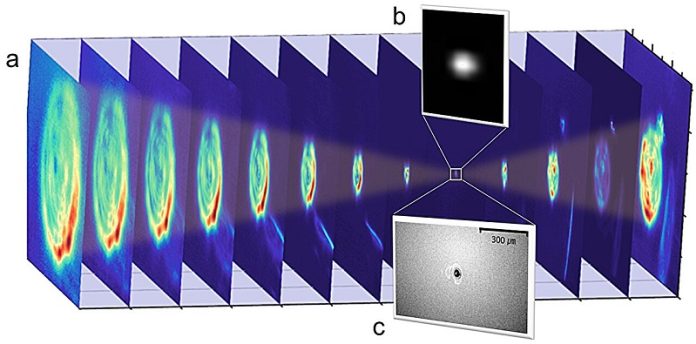
A team of scientists from Korea and the United States has created the world’s most powerful terahertz pulses, capable of instantly ionizing atoms and molecules to create plasma.
This groundbreaking achievement was published in the journal Light: Science & Applications.
Terahertz waves, which lie between the microwave and infrared regions of the electromagnetic spectrum, have long been non-ionizing.
However, when a sufficient number of terahertz photons are focused, they can become ionizing radiation. This discovery opens up new possibilities in the field of terahertz physics.
Terahertz waves (1 THz = 10¹² Hz) have various applications, including spectroscopy, imaging, sensing, and communication.
High-energy terahertz sources are crucial for these applications, while high-intensity sources are essential for studying new terahertz-matter interactions.
The research team, led by Dr. Chul Kang from the Advanced Photonics Research Institute at the Gwangju Institute of Science and Technology (GIST) in Korea and Professor Ki-Yong Kim from the University of Maryland, has achieved a peak terahertz field strength of 260 megavolts per centimeter (MV/cm).
This intensity is the highest ever recorded for terahertz frequencies, ranging from 0.1 to 20 THz.
To generate these high-energy terahertz pulses, the scientists used a powerful 150-terawatt-class Tilaser.
They converted optical energy into terahertz radiation using a lithium niobate (LiNbO₃) crystal, known for its strong nonlinear properties and high damage resistance. The team used a large-diameter (75 mm) lithium niobate wafer doped with 5% magnesium oxide (MgO) to produce scalable terahertz radiation.
A key factor in this process is phase matching, where the optical laser pulse generating the terahertz radiation must travel at the same speed as the terahertz waves within the lithium niobate.
The team discovered a new phase matching condition in lithium niobate that does not require the conventional tilted pulse front method. This method allowed them to generate high-frequency terahertz waves, peaking around 15 THz, using Tilaser pulses with an 800 nm central wavelength.
This innovative phase matching condition enabled the production of millijoule-level terahertz waves, which can be tightly focused to create strong electromagnetic fields. The team measured peak electric and magnetic field strengths of 260 ± 20 MV/cm and 87 ± 7 T, respectively.
These intense terahertz pulses can tunnel ionize atoms and molecules in various materials, converting them into plasma. The researchers demonstrated terahertz-driven ionization in metals, semiconductors, and polymers.
“Our terahertz source uses a planar lithium niobate crystal and shows promise for further scaling up the output energy and field strength, potentially generating super-strong (~GV/cm) terahertz fields,” the researchers stated.
The team believes their work will open new avenues for studying nonlinear effects in terahertz-produced plasmas and utilizing terahertz-driven forces for various applications.
These include multi-keV terahertz harmonic generation and studying relativistic effects by accelerating electrons with terahertz radiation.
This breakthrough not only enhances our understanding of terahertz physics but also holds potential for numerous technological advancements in fields requiring high-intensity terahertz sources.



